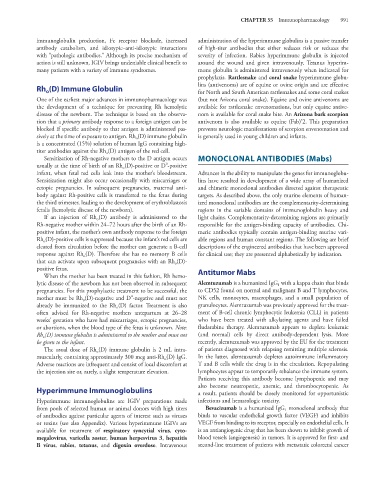Page 1005 - Basic _ Clinical Pharmacology ( PDFDrive )
P. 1005
CHAPTER 55 Immunopharmacology 991
immunoglobulin production, Fc receptor blockade, increased administration of the hyperimmune globulins is a passive transfer
antibody catabolism, and idiotypic–anti-idiotypic interactions of high-titer antibodies that either reduces risk or reduces the
with “pathologic antibodies.” Although its precise mechanism of severity of infection. Rabies hyperimmune globulin is injected
action is still unknown, IGIV brings undeniable clinical benefit to around the wound and given intravenously. Tetanus hyperim-
many patients with a variety of immune syndromes. mune globulin is administered intravenously when indicated for
prophylaxis. Rattlesnake and coral snake hyperimmune globu-
Rh (D) Immune Globulin lins (antivenoms) are of equine or ovine origin and are effective
o
for North and South American rattlesnakes and some coral snakes
One of the earliest major advances in immunopharmacology was (but not Arizona coral snake). Equine and ovine antivenoms are
the development of a technique for preventing Rh hemolytic available for rattlesnake envenomations, but only equine antive-
disease of the newborn. The technique is based on the observa- nom is available for coral snake bite. An Arizona bark scorpion
tion that a primary antibody response to a foreign antigen can be antivenom is also available as equine (Fab)′2. This preparation
blocked if specific antibody to that antigen is administered pas- prevents neurologic manifestations of scorpion envenomation and
sively at the time of exposure to antigen. Rh (D) immune globulin is generally used in young children and infants.
o
is a concentrated (15%) solution of human IgG containing high-
titer antibodies against the Rh (D) antigen of the red cell.
o
Sensitization of Rh-negative mothers to the D antigen occurs MONOCLONAL ANTIBODIES (Mabs)
u
usually at the time of birth of an Rh (D)-positive or D -positive
o
infant, when fetal red cells leak into the mother’s bloodstream. Advances in the ability to manipulate the genes for immunoglobu-
Sensitization might also occur occasionally with miscarriages or lins have resulted in development of a wide array of humanized
ectopic pregnancies. In subsequent pregnancies, maternal anti- and chimeric monoclonal antibodies directed against therapeutic
body against Rh-positive cells is transferred to the fetus during targets. As described above, the only murine elements of human-
the third trimester, leading to the development of erythroblastosis ized monoclonal antibodies are the complementarity-determining
fetalis (hemolytic disease of the newborn). regions in the variable domains of immunoglobulin heavy and
If an injection of Rh (D) antibody is administered to the light chains. Complementarity-determining regions are primarily
o
Rh-negative mother within 24–72 hours after the birth of an Rh- responsible for the antigen-binding capacity of antibodies. Chi-
positive infant, the mother’s own antibody response to the foreign meric antibodies typically contain antigen-binding murine vari-
Rh (D)-positive cells is suppressed because the infant’s red cells are able regions and human constant regions. The following are brief
o
cleared from circulation before the mother can generate a B-cell descriptions of the engineered antibodies that have been approved
response against Rh (D). Therefore she has no memory B cells for clinical use; they are presented alphabetically by indication.
o
that can activate upon subsequent pregnancies with an Rh (D)-
o
positive fetus. Antitumor Mabs
When the mother has been treated in this fashion, Rh hemo-
lytic disease of the newborn has not been observed in subsequent Alemtuzumab is a humanized IgG with a kappa chain that binds
1
pregnancies. For this prophylactic treatment to be successful, the to CD52 found on normal and malignant B and T lymphocytes,
u
mother must be Rh (D)-negative and D -negative and must not NK cells, monocytes, macrophages, and a small population of
o
already be immunized to the Rh (D) factor. Treatment is also granulocytes. Alemtuzumab was previously approved for the treat-
o
often advised for Rh-negative mothers antepartum at 26–28 ment of B-cell chronic lymphocytic leukemia (CLL) in patients
weeks’ gestation who have had miscarriages, ectopic pregnancies, who have been treated with alkylating agents and have failed
or abortions, when the blood type of the fetus is unknown. Note: fludarabine therapy. Alemtuzumab appears to deplete leukemic
Rh (D) immune globulin is administered to the mother and must not (and normal) cells by direct antibody-dependent lysis. More
o
be given to the infant. recently, alemtuzumab was approved by the EU for the treatment
(D) immune globulin is 2 mL intra- of patients diagnosed with relapsing remitting multiple sclerosis.
The usual dose of Rh o
muscularly, containing approximately 300 mcg anti-Rh (D) IgG. In the latter, alemtuzumab depletes autoimmune inflammatory
o
Adverse reactions are infrequent and consist of local discomfort at T and B cells while the drug is in the circulation. Repopulating
the injection site or, rarely, a slight temperature elevation. lymphocytes appear to temporarily rebalance the immune system.
Patients receiving this antibody become lymphopenic and may
Hyperimmune Immunoglobulins also become neutropenic, anemic, and thrombocytopenic. As
a result, patients should be closely monitored for opportunistic
Hyperimmune immunoglobulins are IGIV preparations made infections and hematologic toxicity.
from pools of selected human or animal donors with high titers Bevacizumab is a humanized IgG monoclonal antibody that
1
of antibodies against particular agents of interest such as viruses binds to vascular endothelial growth factor (VEGF) and inhibits
or toxins (see also Appendix). Various hyperimmune IGIVs are VEGF from binding to its receptor, especially on endothelial cells. It
available for treatment of respiratory syncytial virus, cyto- is an antiangiogenic drug that has been shown to inhibit growth of
megalovirus, varicella zoster, human herpesvirus 3, hepatitis blood vessels (angiogenesis) in tumors. It is approved for first- and
B virus, rabies, tetanus, and digoxin overdose. Intravenous second-line treatment of patients with metastatic colorectal cancer

